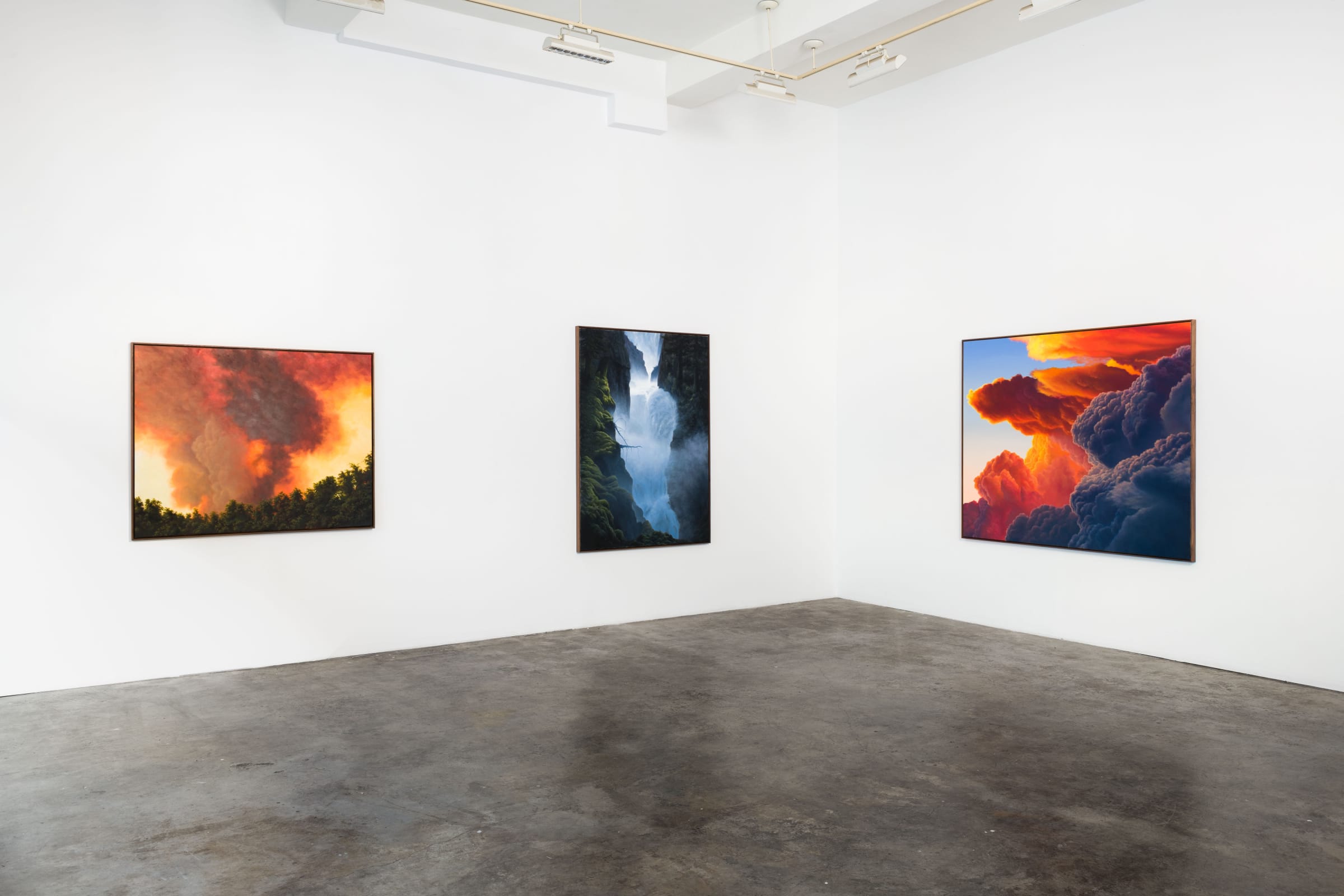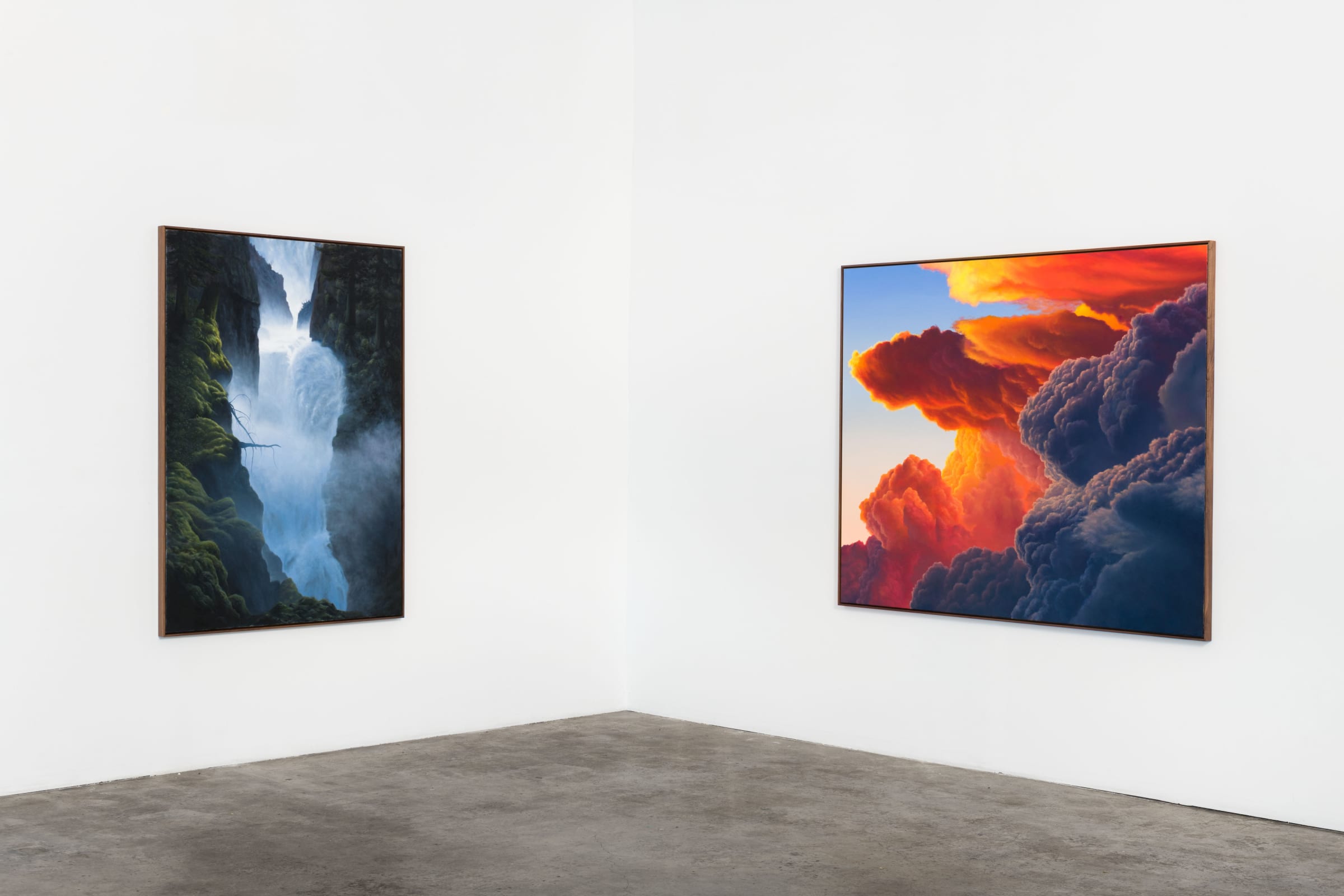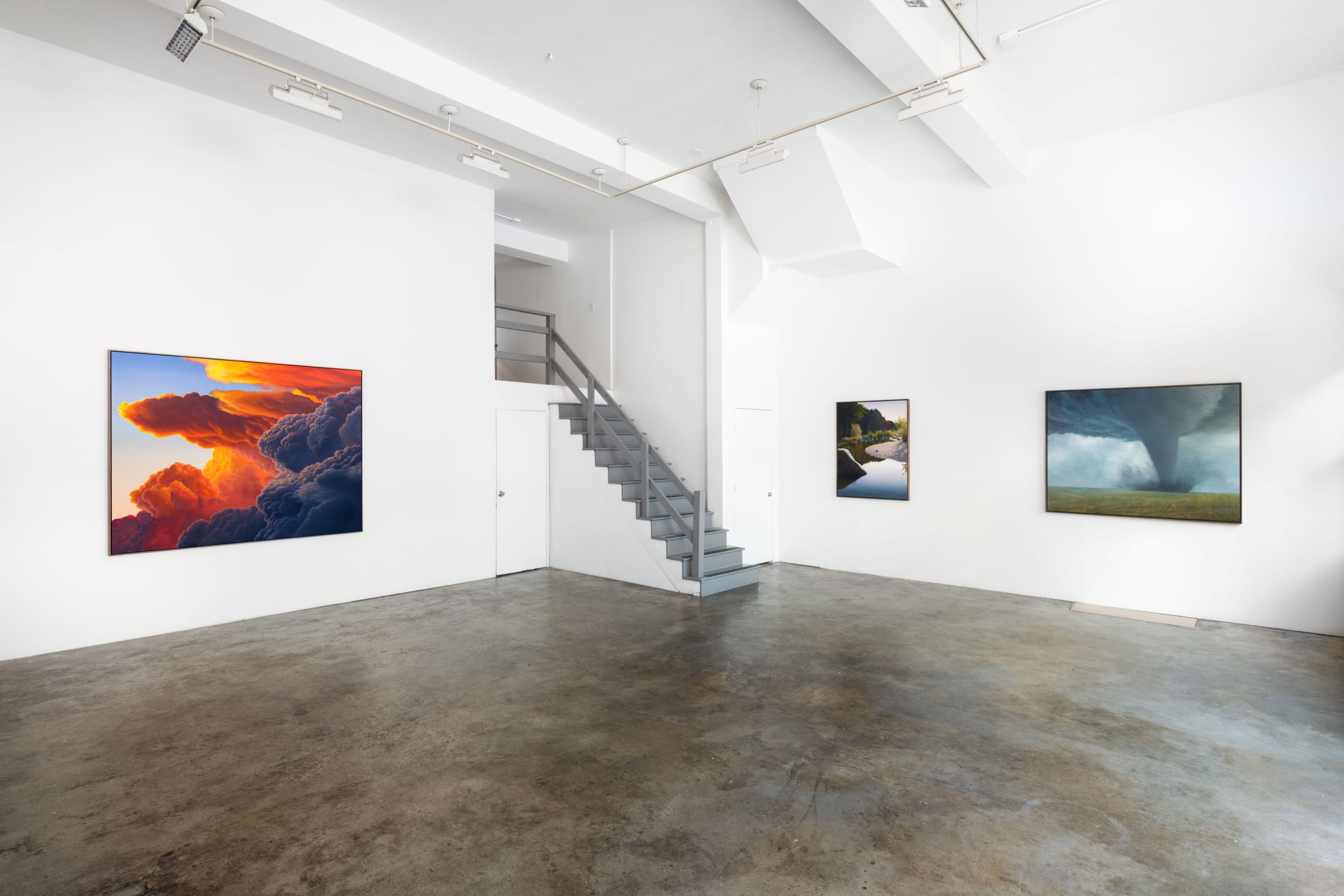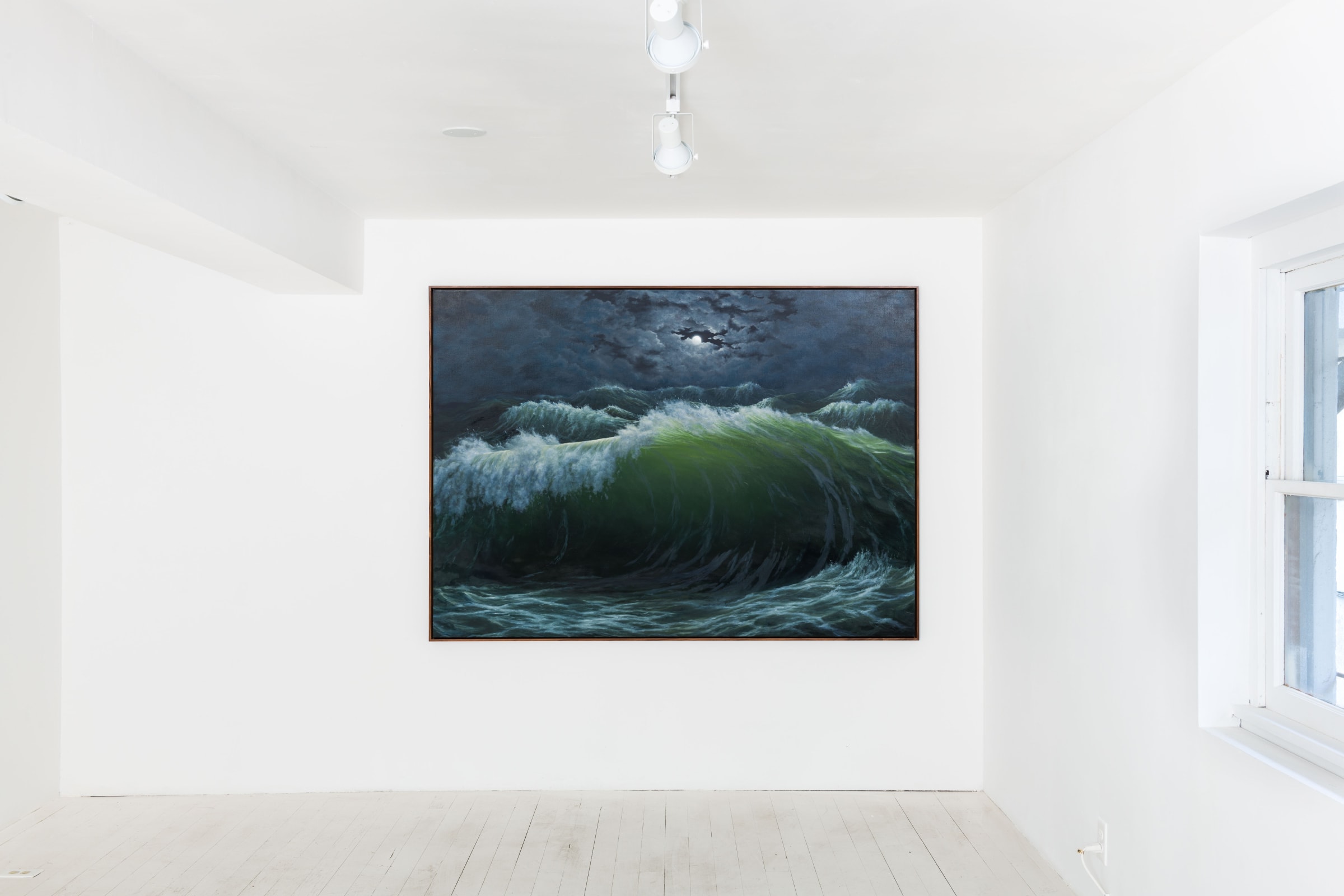Chad Murray "Light and Colour": Chinatown
Sebastian Gladstone is thrilled to announce “Light and Colour”, The first solo exhibition of paintings by Chad Murray. The exhibition will open at the Chinatown gallery on Saturday October 29th from 6-9pm and will continue through December 10th, 2022.
A tornado cuts across the plains, rabid winds funneling down into an atmospheric jackhammer ravaging the grasslands, spits of dirt spew every which way. The jagged Big Sur coastline sprawls south, its massive granite feet jutting into the Pacific Ocean, angular sunbeams offset by a layer of frothy mist hovering just above the water's foreboding emerald surface. A wild fire plumes up over a crescent canopy of trees, its thick three-headed billow nearly blots out the amber-tinged sky.
Chad Murray's paintings express a meditation on the unrelenting awe of nature; their confluence offering a graduated proof of concept. In "Light & Colour", the LA-based artist's first one-person exhibit at Sebastian Gladstone Gallery, Murray's primary conceptual mission is to evoke and explore the sublime using only the most rudimentary tools of the painter.
As well as being the title of Murray's show, "Light & Colour" is also the title of a bombastic late career masterwork by the British painter JW Turner. In 1757, Edmund Burke in A Philosophical Enquiry into the Origin of our Ideas of the Sublime and Beautiful defined "the sublime" as an, 'artistic effect productive of the strongest emotion the mind is capable of feeling.' The spine of Burke's argument was all but built on [the] paintings of Turner.
In the nine paintings that make up Murray's meticulously varied offering, the viewer is given a vibrant and opulent primary on the many ways to skin said conceptual cat. Scanning the gallery walls, the aesthetic spectrum unfolds, expressing a visually pulsating melody; some of the works trafficking in what one might label "all out apocalypse"—fires, tornadoes, tidal waves—while others convey a much more intimate stew of emotions—swollen boisterously-hued clouds, luxurious waterfalls, moody mossy swamps—the more nuanced intentions of the latter lending a welcome caesura to the formers' otherwise bold-faced sturm and drang.
The origins of "Light & Colour" were entirely organic, says Murray, recalling, "setting himself free to paint until eventually a path revealed itself." What began as a small tornado painting, morphed into a pair of waterfall canvases, then mutated into an explosive yet oddly serene wildfire. Within Murray's quiver of oils, the viewer is enveloped by a consciously curated universe of nature. A world void of the human form capturing moments whose cataclysmic effects often promise to impact humankind. Beyond the absence of the human figure, it's worth noting the "position of the viewer" which, in several works, seems to almost hover out in mid-air. At the same time, the titles of the works function as yet another sly homage to Turner, refraining from ever being too on the nose. "Full Moon" does not bother to mention the tidal wave billowing in the foreground of its composition while "Plain With Distant Trees" ignores that havoc being reeked by the tornado tearing through the center of the visual plain. Both the paintings and their titles raise skepticism as to what exactly functions as the subject of the artist's compositions.
That said, from the very beginning of the "Light & Colour" series, Murray harbored a certain wariness about producing an entire show of "disaster paintings about climate change." Ultimately, the artist's intentions were much more about rendering a body of works rooted in a painterly tradition and the formal conditions and challenges of said medium. Even more to the point, Murray's target was not so much about the landscapes per se but about the events, phenomena or a feeling conveyed in each piece. Aligning the work with that of the Hudson River School Artists; nearly 150 years later, Murray’s work revolves more around the staggering effects of bearing witness to nature in all its immensity. Simply put, a vibrant and chilling sublime flex set in a natural world which, in the years since the artist’s Hudson River predecessors, has taken on the ominous burden of man’s abuse and neglect.
Almost all the works in "Light & Colour" manage the tenuous feat of transcending the concrete nature of their figurative subject matter and shapeshift into their own uniquely culled kind of abstraction. The artist adding that, "any of my attempts at ‘pure abstraction’ always felt relatively arbitrary. Ultimately, I’d say I’m less interested in material being material and more into giving material a purpose."
Bolstered by this lofty intention, the paintings in "Light & Colour", also benefit greatly from the guidance of Murray's near-deadly hand though, at times, the artist still demonstrates the ability to pull back to achieve an wonderfully leavened compositional effect as Murray continues to find that restraint is an essential component.
Despite the technical depth of his toolbox, Murray's ultimate goal in "Light & Colour" exists within the sublime. Evidence to that effect runs through every piece; writ large by a kind of natural magic limned in shimmering light and voluminous air. Given said parameters Murray's notes it was "the pretty ones" that presented the biggest challenge. "It's easy to commit to the pursuit of the sublime but being comfortable with the picturesque is a lot scarier, it seems like much more dangerous territory." Minimalist epiphanies are much trickier to convey than those launched by a tidal wave or tornado. In the end, however, regardless of scale, Murray has rendered a room rife with works that surmise the fleeting nature of our universal existence; the ever elusive lightning in a bottle. "That each painting exists in and conveys a really specific moment, that's the most important part for me."
-Arty Nelson
-
 Chad Murray, Cumulonimbus, 2022
Chad Murray, Cumulonimbus, 2022 -
 Chad Murray, Full moon, 2022
Chad Murray, Full moon, 2022 -
 Chad Murray, Plain with Distant Trees, 2022
Chad Murray, Plain with Distant Trees, 2022 -
 Chad Murray, Big Tujunga, 2022
Chad Murray, Big Tujunga, 2022 -
 Chad Murray, Orange Sky, 2022
Chad Murray, Orange Sky, 2022 -
 Chad Murray, Peaches and Creme, 2022
Chad Murray, Peaches and Creme, 2022 -
 Chad Murray, Receding Coastline, 2022
Chad Murray, Receding Coastline, 2022 -
 Chad Murray, The Field of Tall Grass, 2022
Chad Murray, The Field of Tall Grass, 2022 -
 Chad Murray, Trees with Spanish Moss, 2022
Chad Murray, Trees with Spanish Moss, 2022




















